Teltonika – RUT142 – RUT142 – industrial Ethernet router, 1 serial RS232 interface, 2 Ethernet ports
incl. 19% VAT plus shipping costs
The RUT142 is a compact industrial Ethernet router that increases safety by providing network isolation for end devices. Equipped with a serial RS232 interface, two Ethernet ports, a DIN mounting rail and a 3-pin industrial connector, it offers…
| SKU | 386906 |
|---|---|
| EAN | 4779051840724 |
| MPN | RUT142 |
| Categories | Networking, Routers & Switch |
| Tags | Networking, Router, Teltonika |
The RUT142 is a compact industrial Ethernet router that increases safety by providing network isolation for end devices. Equipped with a serial RS232 interface, two Ethernet ports, a DIN mounting rail and a 3-pin industrial connector, it offers seamless connectivity and easy installation. The router features RutOS, Wi-Fi 4 and supports industrial protocols such as Modbus, DLMS, DNP3 and OPC UA and is RMS-compatible for efficient remote and on-site management.
Specification
WIRELESS
– Wireless mode: IEEE 802.11b/g/n, Access Point (AP), Station (STA)
– Wi-Fi security: WPA3-EAP, WPA3-SAE, WPA2-Enterprise-PEAP, WPA2-PSK; AES-CCMP, TKIP, auto-cipher modes, client separation
– SSID/ESSID: ESSID stealth mode
– Wi-Fi users: Up to 50 simultaneous connections
– Wireless connectivity features: Wireless Mesh (802.11s), Fast Roaming (802.11r), Relayd, BSS Transition Management (802.11v), Radio Resource Metering (802.11k)
– Wireless MAC Filter: Whitelist, Blacklist
– Wireless QR Code Generator: Once scanned, a user is automatically let into your network without having to enter any credentials.
ETHERNET
– WAN: 1 x WAN port 10/100 Mbps, compliance with IEEE 802.3, IEEE 802.3u, 802.3az standards, supports Auto-MDI/MDIX crossover
– LAN: 1 x LAN ports, 10/100 Mbps, compliance with IEEE 802.3, IEEE 802.3u, 802.3az standards, supports Auto-MDI/MDIX crossover
NETWORK
– Routing: Static routing, dynamic routing (BGP, OSPF v2, RIP v1/v2, EIGRP, NHRP), policy-based routing
– Network protocols: TCP, UDP, IPv4, IPv6, ICMP, NTP, DNS, HTTP, HTTPS, SFTP, FTP, SMTP, SSL/TLS, ARP, VRRP, PPP, PPPoE, UPNP, SSH, DHCP, Telnet, SMPP, SNMP, MQTT, Wake On Lan (WOL)
– VoIP passthrough support: H.323- and SIP-alg protocol NAT helpers that enable the correct routing of VoIP packets
– Connection monitoring: Ping reboot, Wget reboot, periodic reboot, LCP and ICMP for link inspection
– Firewall: Port forwarding, traffic rules, user-defined rules
– Firewall status page: Display all firewall statistics, rules and rule counters
– Ports management: display device ports, activate and deactivate individual ports, switch autoconfiguration on and off, change transmission speed, etc.
– Network topology: Visual representation of your network showing which devices are connected to which other devices
– DHCP: Static and dynamic IP assignment, DHCP relay, DHCP server configuration, status, static leases: MAC with wildcards
– QoS / Smart Queue Management (SQM): Traffic priority queuing by source/destination, service, protocol or port, WMM, 802.11e
– DDNS: Supports >25 service providers, others can be configured manually
– Network backup: Wi-Fi WAN, VRRP, wired options, any of which can be used as automatic failover
– Load balancing: Balancing Internet traffic across multiple WAN connections
– Hotspot: Captive portal (hotspot), internal/external Radius server, Radius MAC authentication, SMS authorisation, internal/external landing page, walled garden, user scripts, URL parameters, user groups, individual user or group restrictions, user management, 9 default customisable themes and the ability to upload and download custom hotspot themes
– SSHFS: Ability to mount a remote file system via the SSH protocol
SECURITY
– Authentication: pre-shared key, digital certificates, X.509-certificates, TACACS+, Radius, blocking of IP and login attempts, time-based login blocking, in-built random password generator
– Firewall: Pre-configured firewall rules can be activated via WebUI, unlimited firewall configuration via CLI; DMZ; NAT; NAT-T
– Attack protection: DDOS protection (SYN flood protection, SSH attack protection, HTTP/HTTPS attack protection), port scan protection (SYN-FIN, SYN-RST, X-mas, NULL flags, FIN scan attacks)
– VLAN: Port and tag-based VLAN separation
– WEB filter: blacklist for blocking unwanted websites, whitelist for specifying only permitted websites
– Access control: flexible access control of SSH, web interface, CLI and Telnet
VPN
– OpenVPN: multiple clients and a server can run simultaneously, 27 encryption methods
– OpenVPN encryption: DES-CBC 64, RC2-CBC 128, DES-EDE-CBC 128, DES-EDE3-CBC 192, DESX-CBC 192, BF-CBC 128, RC2-40-CBC 40, CAST5-CBC 128, RC2-64-CBC 64, AES-128-CBC 128, AES-128-CFB 128, AES-128-CFB1 128, AES-128-CFB8 128, AES-128-OFB 128, AES-128-GCM 128, AES-192-CFB 192, AES-192-CFB1 192, AES-192-CFB8 192, AES-192-OFB 192, AES-192-CBC 192, AES-192-GCM 192, AES-256-GCM 256, AES-256-CFB 256, AES-256-CFB1 256, AES-256-CFB8 256, AES-256-OFB 256, AES-256-CBC 256
– IPsec: IKEv1, IKEv2, with 14 encryption methods for IPsec (3DES, DES, AES128, AES192, AES256, AES128GCM8, AES192GCM8, AES256GCM8, AES128GCM12, AES192GCM12, AES256GCM12, AES128GCM16, AES192GCM16, AES256GCM16)
– GRE: GRE tunnels, GRE tunnels via IPsec support
– PPTP, L2TP: client/server instances can run simultaneously, L2TPv3, L2TP via IPsec support
– Stunnel: proxy for adding TLS encryption functionality to existing clients and servers without changes to the programme code
– DMVPN: Method for building scalable IPsec VPNs
– SSTP: Support for SSTP client instances
– ZeroTier: ZeroTier VPN client support
– WireGuard: WireGuard VPN client and server support
– Tinc: Tinc provides encryption, authentication and compression in its tunnels. Client and server support.
OPC UA
– Supported modes: Client, Server
– Supported connection types: TCP
MODBUS
– Supported modes: Server, Client
– Supported connection types: TCP, RTU (RS232)
– User-defined registers: MODBUS TCP user-defined register block requests that can read/write a file within the router and be used to extend MODBUS TCP client functionality
– Supported data formats: 8-bit: INT, UINT; 16-bit: INT, UINT (MSB or LSB first); 32-bit: float, INT, UINT (ABCD (big-endian), DCBA (little-endian), CDAB, BADC), HEX, ASCII
DATATO SERVER
– Protocol: HTTP(S), MQTT, Azure MQTT
– Data to server: Extracts parameters from multiple sources and different protocols and sends them all to a single server
MQTTGATEWAY
– MODBUS MQTT Gateway: Enables commands to be sent and data to be received from the MODBUS server via the MQTT broker
DNP3
– Supported modes: station, outstation
– Supported connections: TCP, RTU(RS232)
DLMS
– DLMS support: DLMS – Standard protocol for exchanging meter data
– Supported modes: Client
– Supported connection types: TCP, RTU(RS232)
API
– Teltonika Networks Web API (beta) support: extend the capabilities of your device by using a range of configurable API endpoints to retrieve or modify data. For more information, please read this documentation: https://developers.teltonika-networks.com
MONITORING & MANAGEMENT
– WEB UI: HTTP/HTTPS, status, configuration, FW update, CLI, troubleshooting, multiple event log servers, firmware update availability notifications, event log, system log, kernel log, internet status
– FOTA: firmware update from server, automatic notification
– SSH: SSH (v1, v2)
– Email: Email notification of the status of various services
– TR-069: OpenACS, EasyCwmp, ACSLite, tGem, LibreACS, GenieACS, FreeACS, LibCWMP, Friendly tech, AVSystem
– MQTT: MQTT Broker, MQTT Publisher
– SNMP: SNMP (v1, v2, v3), SNMP Trap
– JSON-RPC: Management API via HTTP/HTTPS
– RMS: Teltonika Remote Management System (RMS)
IOTPLATFORMS
– Cloud of Things: Enables monitoring of: Device name, HW version, serial number, FW version, WAN IP. Enables actions from the cloud: FW update, restart
– ThingWorx: Enables monitoring of: Device name, HW version, serial number, FW version, WAN IP. Enables actions from the cloud: FW update, restart
– Azure IoT Hub: Enables monitoring of: Wan IP, number of bytes sent/received, model, manufacturer, serial number, revision, FW version and collected data from industrial devices
SYSTEM SPECIFICATIONS
– CPU: Mediatek, 580 MHz, MIPS 24KEc
– RAM: 128 MB, DDR2
– FLASH memory: 16 MB serial NOR flash
FIRMWARE/ CONFIGURATION
– WEB UI: Update FW from file, check FW on server, configuration profiles, configuration backup
– FOTA: Update FW
– RMS: Update FW/configuration for multiple devices at once
– Maintain settings: Update FW without losing the current configuration
– Reset factory settings: A full factory reset restores all system settings, including IP address, PIN and user data, to the manufacturer’s default configuration
FIRMWARECUSTOMISATION
– Operating system: RutOS (OpenWrt based Linux OS)
– Supported languages: Busybox shell, Lua, C, C++
– Development tools: SDK package with build environment provided
– GPL customisation: you can create your own custom firmware and website application by changing colours, logos and other elements in our firmware to suit your needs or those of your customers.
POWER
– Connection: 3-pin pluggable terminal block
– Input voltage range: 9-30 VDC, reverse polarity protection, overvoltage protection >31 VDC 10us max
– PoE (passive): Passive PoE via free pairs. Power supply option via the LAN1 port, not compatible with the IEEE802.3af, 802.3at and 802.3bt, mode B, 9 – 30 VDC
– Power consumption: Idle: < 1 W / Max: < 2 W
PHYSICAL INTERFACES
– Ethernet: 2 x RJ45 ports, 10/100 Mbps
– Status LEDs: 1 x WAN type LED, 1 x LAN type LED, 1 x power LED
– Power: 1 x 3-pin power connector
– Antennas: 1 x RP-SMA for Wi-Fi
– RS232: 1 x DB9 socket
– Reset: Restart/user default reset/factory reset button
– Miscellaneous: 1 x earthing screw
PHYSICAL SPECIFICATIONS
– Housing material: aluminium housing
– Dimensions (W x H x D): 113.10 x 25 x 68.6 mm
– Weight: 149.2 g
– Mounting options: Integrated DIN rail bracket, wall mounting, flat surface (additional kit required)
OPERATING ENVIRONMENT
– Operating temperature: -40 °C to 75 °C
– Operating humidity: 10 % to 90 % non-condensing
– Protection class: IP30
REGULATORY & TYPE APPROVALS
– Regulations: CE/RED, UKCA, CB, RCM, FCC, IC, EAC, UCRF, WEEE

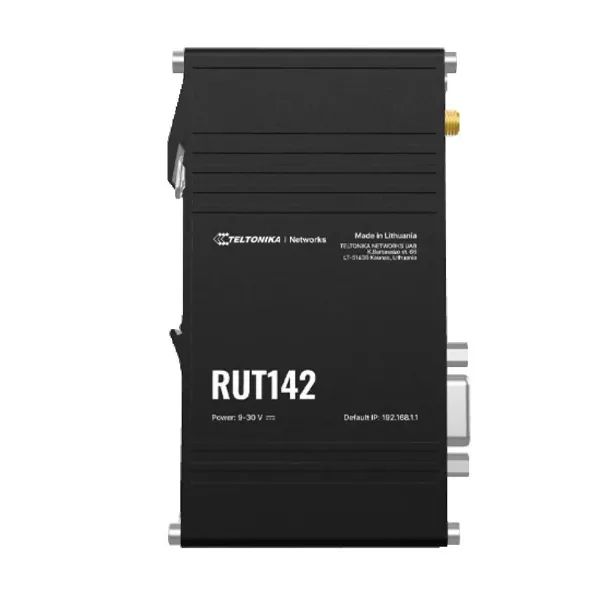
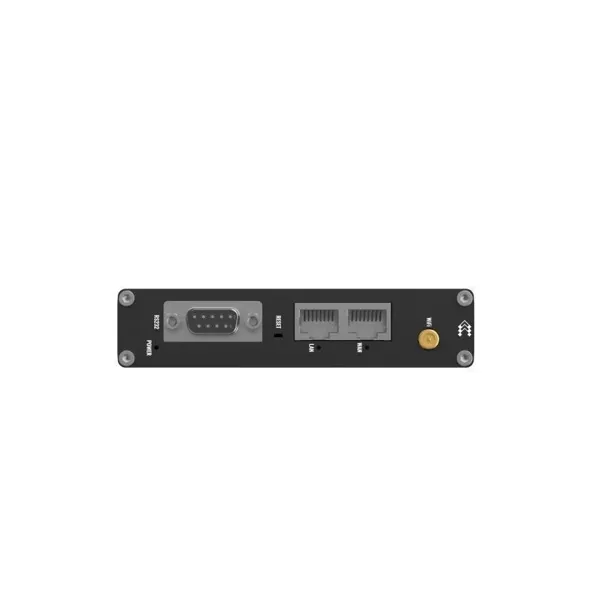

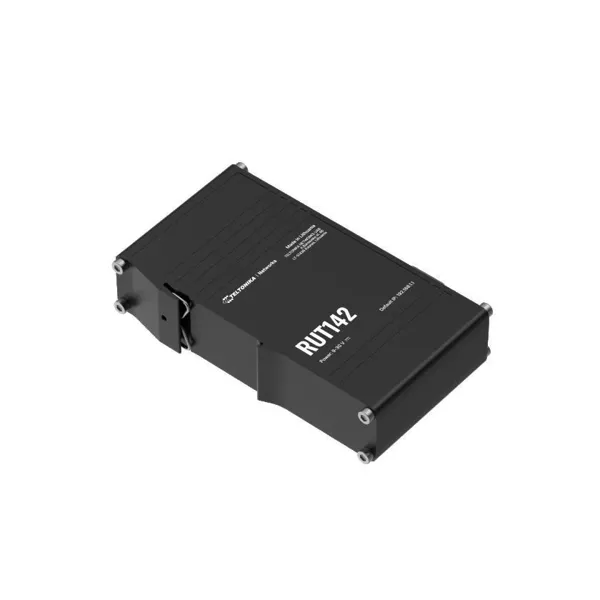
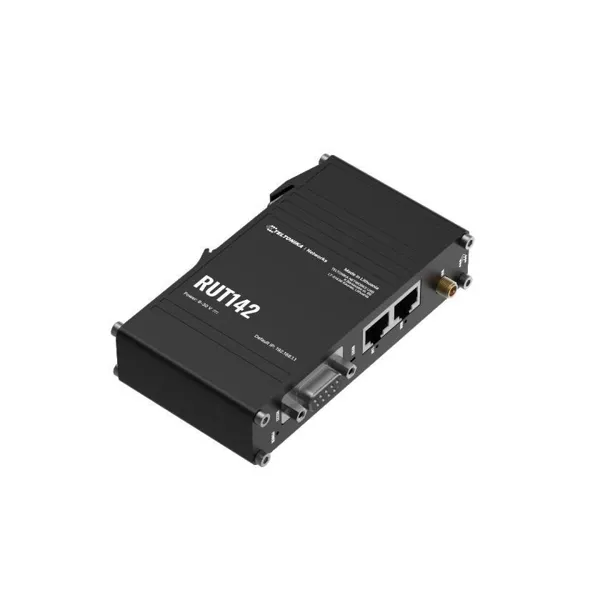

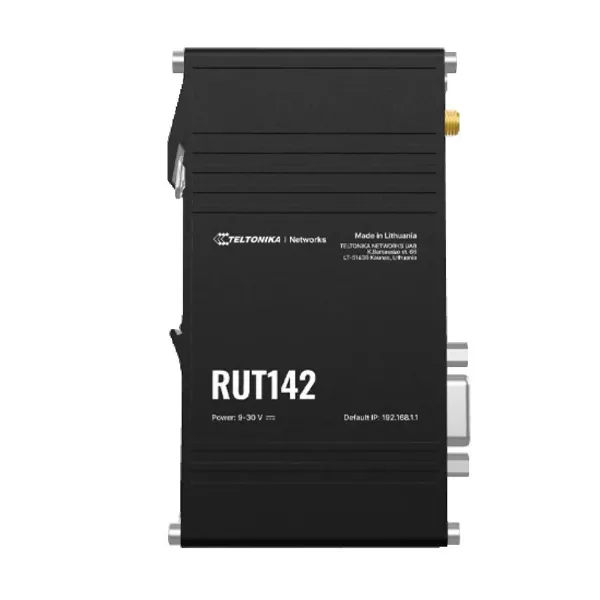
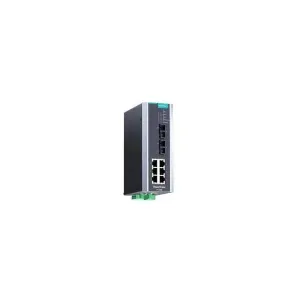

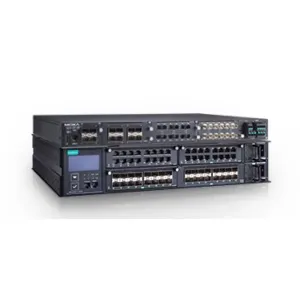
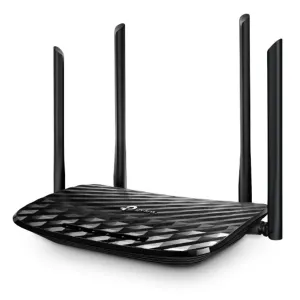
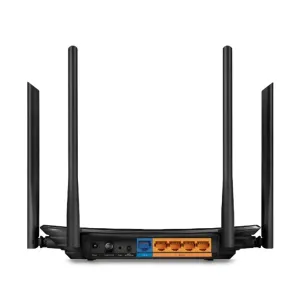
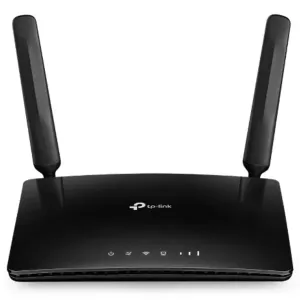
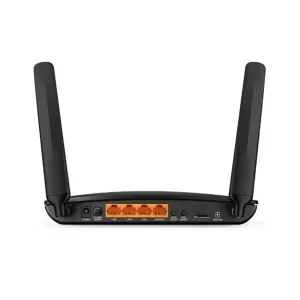
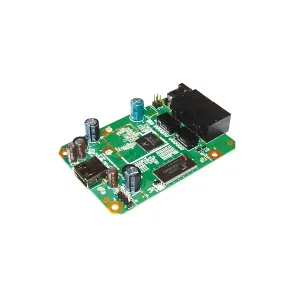
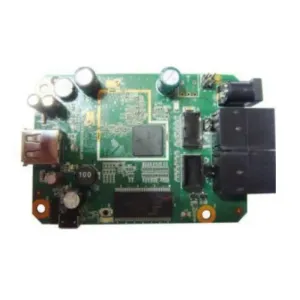
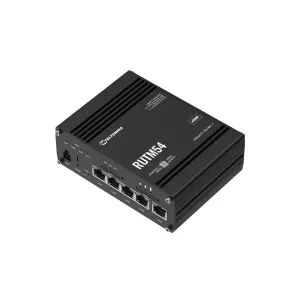 Teltonika - RUTM54 - 5G ROUTER WITH TELIT MODEM
Teltonika - RUTM54 - 5G ROUTER WITH TELIT MODEM